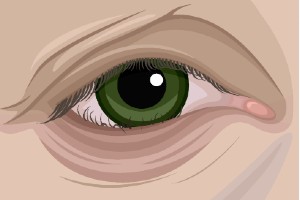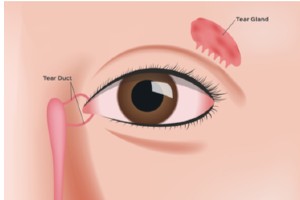Oculoplasty Procedure
![]()
A variety of diseases and injuries can affect the eyes, eyelids, and surrounding areas. Oculoplasty, also known as ophthalmic plastic procedure is performed to treat diseases with relation to the eye and its surrounding structures.
When the skin and external factors in and around the eye affect the field of vision and cause damage to the eye, such procedures are performed. This may improve function, comfort and appearance for the following conditions such as Tear Drainage Problems, Eyelid Malposition, Skin Cancers of the Eyelid, Problems of the eye socket and problems related to eyebrow.
Entropion
 Entropion is a condition where the eyelid turns inward causing the eyelashes and skin to rub against the eyes surface.
Entropion is a condition where the eyelid turns inward causing the eyelashes and skin to rub against the eyes surface.
This causes irritation and discomfort. Entropion is more common in older adults, and it generally affects only the lower eyelid.
Symptoms
The signs and symptoms of entropion result from the friction of your eyelashes and outer eyelid against the surface of your eye. You may experience:
Diagnosis
Entropion can usually be diagnosed with a routine eye exam and physical. Your doctor may pull on your eyelids during the exam or ask you to blink or close your eyes forcefully. This helps him or her assess your eyelid’s position on the eye, its muscle tone and its tightness. If your entropion is caused by scar tissue, previous surgery or other conditions, your doctor will examine the surrounding tissue as well.
Treatment
Nonsurgical treatments: They are available to relieve symptoms and protect your eye from damage. When active inflammation or infection causes entropion (spastic entropion), your eyelid may return to its normal alignment as you treat the inflamed or infected eye. But if tissue scarring has occurred, entropion may persist even after the other condition has been treated.
A Procedure is generally required to fully correct entropion, but short-term fixes such as Soft contact lens, Botox, Stitches that turn the eyelid outward and Skin tape can be useful.
The type of procedure you have depends on the condition of the tissue surrounding the eyelid and on the cause of your entropion. If entropion is age related our expert will likely remove a small part of the lower eyelid. This helps tighten the affected tendons and muscles. There will be few stitches on the outside corner of the eye or just below your lower eyelid.
Ectropion
 Ectropion is a condition in which the eyelid turns outward. This leaves the inner eyelid surface exposed and prone to irritation. Ectropion is more common in older adults, and it generally affects only the lower eyelid. In severe ectropion, the entire length of the eyelid is turned out. In less severe ectropion, only one segment of the eyelid sags away from the eye.
Ectropion is a condition in which the eyelid turns outward. This leaves the inner eyelid surface exposed and prone to irritation. Ectropion is more common in older adults, and it generally affects only the lower eyelid. In severe ectropion, the entire length of the eyelid is turned out. In less severe ectropion, only one segment of the eyelid sags away from the eye.
Lubricating ointments can help relieve symptoms. But usually procedure is needed to fully correct the conditions. Left untreated, entropion can cause damage to the cornea, eye infections and vision loss.
Symptoms
Diagnosis
Ectropion can usually be diagnosed with a routine eye exam. Your doctor may pull on your eyelids during the exam or ask you to close your eyes forcefully. This helps him or her assess each eyelid’s muscle tone and tightness. If your ectropion is caused by a scar, tumor, previous surgery or radiation, your doctor will examine the surrounding tissue as well. Understanding how other conditions cause ectropion is important in choosing the correct treatment or surgical technique.
Treatment
If ectropion is mild, the surgeon may recommend artificial tears and ointments to ease the symptoms. A procedure is generally required to completely correct ectropion.
The type of procedure you have depends on the condition of the tissue surrounding your eyelid and on the cause of your ectropion such as, Ectropion caused by muscle and ligament relaxation due to aging. Your surgeon will likely remove a small part of your lower eyelid at the outer edge. When the lid is stitched back together, the tendons and muscles of the lid will be tightened, causing the lid to rest properly on the eye. This procedure is generally relatively simple.
Blocked Tear Duct
 When you have a blocked tear duct, your tears can’t drain normally, leaving you with a watery, irritated eye.Partial or complete obstruction in the tear drainage system are the cause of this condition. Newborns are commonly seen to have a blocked tear duct which usually gets better without any treatment as they grow.
When you have a blocked tear duct, your tears can’t drain normally, leaving you with a watery, irritated eye.Partial or complete obstruction in the tear drainage system are the cause of this condition. Newborns are commonly seen to have a blocked tear duct which usually gets better without any treatment as they grow.
Blocked tear ducts in adults may be due to an injury, an infection or rarely, a tumor. A blocked tear duct in many cases is almost correctable. Treatment depends on the cause of the blockage and the age of the affected person.
Symptoms
Diagnosis
To diagnose your condition, your doctor talks with you about your symptoms, examines your eyes and does a few tests. He or she will also examine the inside of your nose to determine if any structural disorders of your nasal passages are causing an obstruction. If your doctor suspects a blocked tear duct, he or she may have you undergo other tests to find the location of the blockage.
Tests used to diagnose a blocked tear duct include:
Tear drainage test: By placing a drop of dye on the eye surface to check for how long it stays
Irrigation and probing: Flushing with saline in the tear drain area or inserting a probe into the drain area to check for blockage
Treatment
Treatment depends on what’s causing the blocked tear duct. If a tumor is causing the blocked tear duct, treatment will focus on the cause of the tumor. A procedure may be performed to remove the tumor, or may recommend using other treatments to shrink it.
Symblepharon
A symblepharon is a partial or complete adhesion of the palpebral conjunctiva of the eyelid to the bulbar conjunctiva of the eyeball. It occurs because of an abnormal healing process after injury to the conjunctiva. Most cases of symblepharon are acquired, though it can rarely be congenital, as sometimes seen in cases of cryptophthalmos.
Symptoms
Treatment
Medical management of symblepharon aims to prevent or decrease its formation and to treat the underlying condition. The symptoms of dry eye caused by it can be managed using preservative free artificial tears and eye lubricants.
Procedure involves tissue grafting to the affected areas and reconstruction of a normal fornix. It includes cicatrix lysis and intraoperative mitomycin C (MMC) application are paired with reconstruction using tissue grafts from either oral mucosal transplantation, conjunctival auto grafting, or amniotic membrane transplantation.
Non-healing corneal ulcer
A non-healing corneal ulcer is defined as an ulcer which does not show any indication of healing within two weeks, despite the administration of proper medical treatment. Once a corneal ulcer occurs and is left unattended, corneal melting, descemetocele, and corneal perforation can subsequently develop, leading to devastating consequences.
Symptoms
The signs and symptoms of entropion result from the friction of your eyelashes and outer eyelid against the surface of your eye. You may experience:
Treatment
Tarsorrhaphy is a procedure that involves partially sewing the eyelids together to narrow the eye opening. This procedure is used to help protect the eye from foreign objects and from painful drying in patients with full or partial facial paralysis that has affected eyelid closure. The procedure involves placing stitches at the corners of the eyelid opening to narrow the opening and allow the eye to stay better lubricated and protected from injury. It may be necessary to continue using eye drops and ointments to keep the eye appropriately lubricated, and in many cases, drops and contact lenses are sufficient to prevent the need for tarsorrhaphy altogether.
Clearer Vision is Just a Click Away!
Get yourself cared by the most experienced specialists

